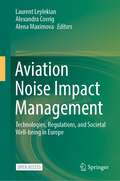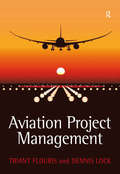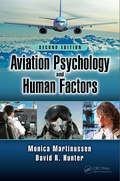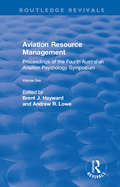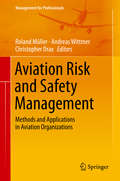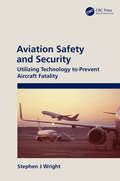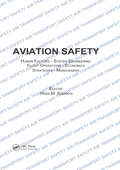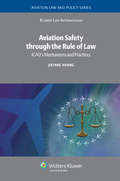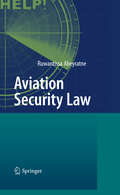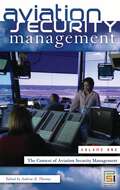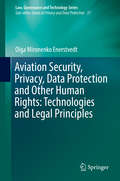- Table View
- List View
Aviation Mental Health: Psychological Implications for Air Transportation
by Todd Hubbard Robert BorThis book provides an authoritative and practical guide to the assessment, management, treatment and care of pilots and other professional groups within aviation; covering a range of relevant topics, for health and human resources practitioners working in the airline industry. Pilot mental health has, hitherto, been regarded as a specialist topic in aviation medicine. Consequently, practitioners and researchers alike have been forced to consult specialist journals or seek out a relevant chapter on this topic in a general textbook to develop or update their understanding of the relevant issues. This book seeks to remedy this situation by gathering together all of the relevant insights into a single authoritative source gathered from the leading specialists in the field. It aims to cover all of the main relevant issues including the assessment, care, management and treatment of mental health problems, as well as the prevention of mental health problems among this occupational group.
Aviation Noise Impact Management: Technologies, Regulations, and Societal Well-being in Europe
by Laurent Leylekian Alexandra Covrig Alena MaximovaThis open access book provides a view into the state-of-the-art research on aviation noise and related annoyance. The book will primarily focus on the achievements of the ANIMA project (Aviation Noise Impact Management through Novel Approaches), but not exclusively.The content has a broader theme in order to encompass. regulation issues, the ICAO (International Civil Aviation Organization) balanced approach, progresses made on technologies and reduction of noise at source, impact of possible future civil supersonic aircraft, land-use planning issues, as well as the core topics of the ANIMA project, i.e. impact on human beings, annoyance, quality of life, health and findings of the project in this respect.This book differs from traditional research programmes on aviation noise as the authors endeavour, not to lower noise at source, but to reduce the annoyance. This book examines these non-acoustic factors in an effort to help those most affected by aviation noise – communities living close to airports, and also help airport managers, policy-makers, local authorities and researchers to deal with this issue holistically. The book concludes with some recommendations for EU, national and local policy-makers, airport and aviation authorities, and more broadly a scientifically literate audience. These recommendations may help to identify gaps for progress in terms of research but also genuine implementation actions for political and regulatory authorities.
Aviation Project Management
by Triant G. Flouris Dennis LockCombining the considerable respective expertise of Triant Flouris and Dennis Lock, this unique book highlights the ways that successful businesses are managed in the aviation industry through the identification and application of proven project management methods. Theoretical concepts are defined, clarified and shown how they can be valuable to business managers and students of the aviation business sector. Aviation Project Management builds on the successful and popular work of Dennis Lock but is considerably enhanced by applications, examples, illustrations and case examples pertaining to projects exclusively from the aviation industry. Theory in the project management field is already well evolved, so the purpose of this book is not to review that theory but rather to demonstrate how the lessons of theory can be of practical use to aviation students and business managers. It provides a practical guide to those interested in how projects are managed and the common mistakes that aviation project managers should avoid.
Aviation Project Management
by Triant G. Flouris Dennis LockCombining the considerable respective expertise of Triant Flouris and Dennis Lock, this unique book highlights the ways that successful businesses are managed in the aviation industry through the identification and application of proven project management methods. Theoretical concepts are defined, clarified and shown how they can be valuable to business managers and students of the aviation business sector. Aviation Project Management builds on the successful and popular work of Dennis Lock but is considerably enhanced by applications, examples, illustrations and case examples pertaining to projects exclusively from the aviation industry. Theory in the project management field is already well evolved, so the purpose of this book is not to review that theory but rather to demonstrate how the lessons of theory can be of practical use to aviation students and business managers. It provides a practical guide to those interested in how projects are managed and the common mistakes that aviation project managers should avoid.
Aviation Psychology and Human Factors
by Monica Martinussen David R. HunterThis book covers the application of psychological principles and techniques to situations and problems of aviation. It offers an overview of the role psychology plays in aviation, system design, selection and training of pilots, characteristics of pilots, safety, and passenger behavior. It covers concepts of psychological research and data analysis and shows how these tools are used in the development of new psychological knowledge. The new edition offers material on physiological effects on pilot performance, a new chapter on aviation physiology, more material on fatigue, safety culture, mental health and safety, as well as practical examples and exercises after each chapter.
Aviation Psychology and Human Factors
by Monica Martinussen David R. HunterThis book covers the application of psychological principles and techniques to situations and problems of aviation. It offers an overview of the role psychology plays in aviation, system design, selection and training of pilots, characteristics of pilots, safety, and passenger behavior. It covers concepts of psychological research and data analysis and shows how these tools are used in the development of new psychological knowledge. The new edition offers material on physiological effects on pilot performance, a new chapter on aviation physiology, more material on fatigue, safety culture, mental health and safety, as well as practical examples and exercises after each chapter.
Aviation Psychology in Practice
by Neil Johnston Nick McDonaldThis book seeks to extend the boundaries of aviation psychology in two interrelated ways: by broadening the focus of aviation psychology beyond the flight deck to the whole aviation system; and by discussing new theoretical developments which are shaping this applied discipline. A key feature of these theoretical advances is that they are grounded in a more developed, ecologically valid, understanding of practice. Among the issues addressed in this new integration of theory and practice are the following: what goes on in the flight deck is dependent on the wider organisational context; human factors issues in aircraft maintenance and grounding are critical to aviation safety; our capacity to learn from aviation accidents and incidents needs to be supported by more systematic human factors investigation and research; we must also develop our understanding of the human factors of accident survival as well as accident prevention; theories of crew coordination and decision making must be supported by an analysis of how decisions are actually made in the real world with all its stresses and constraints; training should be grounded in a thoroughgoing analysis of the complexity of the job and a full understanding of the training process itself. The text will be of interest to human factors researchers and practitioners in aviation and related areas. It will be of particular relevance to those who have a role in training, management or regulation throughout the aviation system.
Aviation Psychology in Practice
by Neil Johnston Nick McDonaldThis book seeks to extend the boundaries of aviation psychology in two interrelated ways: by broadening the focus of aviation psychology beyond the flight deck to the whole aviation system; and by discussing new theoretical developments which are shaping this applied discipline. A key feature of these theoretical advances is that they are grounded in a more developed, ecologically valid, understanding of practice. Among the issues addressed in this new integration of theory and practice are the following: what goes on in the flight deck is dependent on the wider organisational context; human factors issues in aircraft maintenance and grounding are critical to aviation safety; our capacity to learn from aviation accidents and incidents needs to be supported by more systematic human factors investigation and research; we must also develop our understanding of the human factors of accident survival as well as accident prevention; theories of crew coordination and decision making must be supported by an analysis of how decisions are actually made in the real world with all its stresses and constraints; training should be grounded in a thoroughgoing analysis of the complexity of the job and a full understanding of the training process itself. The text will be of interest to human factors researchers and practitioners in aviation and related areas. It will be of particular relevance to those who have a role in training, management or regulation throughout the aviation system.
Aviation Psychology: Practice and Research
by Klaus-Martin GoetersIn the well-established aviation system, the importance of sound human factors practice, based on good aviation psychology research, is obvious from those incidents and accidents resulting from its neglect. This carefully structured book presents an up-to-date review of the main areas in the field of Aviation Psychology. It contains current thinking mainly from Europe, but with input from Australia and North America, from specialists involved in research, training and operational practice. Spanning six parts, the book covers: Human Engineering, Occupational Demands, Selection of Aviation Personnel, Human Factors Training, Clinical Psychology, Accident Investigation and Prevention. Looking at the six parts - in human engineering, the reader learns about human-centered automation as well as human factors issues in aircraft certification. Results derived by job analysis methods are presented in the next part and serve as basic information in the design of selection and training programs. In selection, computerized testing or behaviour-oriented assessments are challenging approaches for personnel recruitment. Cost-benefit analyses in selection reveal convincing results, enabling organizations to save huge amounts of inappropriate training investment by the application of proper selection tests. The NOTECHS method is described which helps to assess CRM capabilities in training and can also be used to measure training effects in systematic validation studies. Although operational personnel in aviation are usually able to cope with stress more efficiently than other occupational groups, individual problems might develop as reactions to traumatic influences. Either a psychological evaluation or a proper treatment or both is then required as described in the 'Clinical Psychology' part of the book. The readership includes: aviation psychologists and flight surgeons, training, selection and recruitment specialists, instructor pilots, CRM facilitators, personnel managers, accident investigators, safety pilots, air traffic controllers, aircraft engineers and those dealing with human-machine interfaces.
Aviation Psychology: Practice and Research
by Klaus-Martin GoetersIn the well-established aviation system, the importance of sound human factors practice, based on good aviation psychology research, is obvious from those incidents and accidents resulting from its neglect. This carefully structured book presents an up-to-date review of the main areas in the field of Aviation Psychology. It contains current thinking mainly from Europe, but with input from Australia and North America, from specialists involved in research, training and operational practice. Spanning six parts, the book covers: Human Engineering, Occupational Demands, Selection of Aviation Personnel, Human Factors Training, Clinical Psychology, Accident Investigation and Prevention. Looking at the six parts - in human engineering, the reader learns about human-centered automation as well as human factors issues in aircraft certification. Results derived by job analysis methods are presented in the next part and serve as basic information in the design of selection and training programs. In selection, computerized testing or behaviour-oriented assessments are challenging approaches for personnel recruitment. Cost-benefit analyses in selection reveal convincing results, enabling organizations to save huge amounts of inappropriate training investment by the application of proper selection tests. The NOTECHS method is described which helps to assess CRM capabilities in training and can also be used to measure training effects in systematic validation studies. Although operational personnel in aviation are usually able to cope with stress more efficiently than other occupational groups, individual problems might develop as reactions to traumatic influences. Either a psychological evaluation or a proper treatment or both is then required as described in the 'Clinical Psychology' part of the book. The readership includes: aviation psychologists and flight surgeons, training, selection and recruitment specialists, instructor pilots, CRM facilitators, personnel managers, accident investigators, safety pilots, air traffic controllers, aircraft engineers and those dealing with human-machine interfaces.
Aviation Resource Management: Proceedings of the Fourth Australian Aviation Psychology Symposium Volume 1 (Routledge Revivals)
by BRENT J. HAYWARD AND ANDREW R. LOWEThis title was first published in 2000. This is volume one of a two-volume set which presents the reader with strategies for the contributions of psychology and human factors to the safe and effective functioning of aviation organizations and systems.Together, the volumes comprise the edited contributions to the Fourth Australian Aviation Psychology Symposium. The chapters within are orientated towards presenting and developing practical solutions for the present and future challenges facing the aviation industry. Each volume covers areas of vital and enduring importance in the complex aviation system. Volume one includes aviation safety, crew resource management, the aircraft cabin, cockpit automation, safety investigation, fatigue and stress, and applied human factors in training.
Aviation Resource Management: Proceedings of the Fourth Australian Aviation Psychology Symposium Volume 1 (Routledge Revivals)
by Brent J. Hayward Andrew R. LoweThis title was first published in 2000. This is volume one of a two-volume set which presents the reader with strategies for the contributions of psychology and human factors to the safe and effective functioning of aviation organizations and systems.Together, the volumes comprise the edited contributions to the Fourth Australian Aviation Psychology Symposium. The chapters within are orientated towards presenting and developing practical solutions for the present and future challenges facing the aviation industry. Each volume covers areas of vital and enduring importance in the complex aviation system. Volume one includes aviation safety, crew resource management, the aircraft cabin, cockpit automation, safety investigation, fatigue and stress, and applied human factors in training.
Aviation Resource Management: Volume 2 - Proceedings of the Fourth Australian Aviation Psychology Symposium
by Andrew R. Lowe Brent J. HaywardThis two volume set presents the reader with new strategies for the contributions of psychology and Human Factors to the safe and effective functioning of aviation organizations and systems. The volumes comprise the edited contributions to the Fourth Australian Aviation Psychology Symposium. The chapters within are orientated towards presenting and developing practical solutions for the current and future challenges facing the aviation industry. Each volume covers areas of vital and enduring importance within today’s complex aviation system. Volume 2 covers Selection, Training, Human-Machine Interface, Air Traffic Control, Maintenance and Situational Awareness. Invited chapters include contributions from Capt. Dañiel Maurino (ICAO), Professor Bob Helmreich (University of Texas), Jean Pariés and Dr. Ashleigh Merritt (Dédale), Professor Ron Westrum (Eastern Michigan University), Capt. Azmi Radzi (Malaysian Airlines), Nicole Svátek (Virgin Atlantic), Professor Patrick Hudson (Leiden University), Dr. Sherry Chappell (Delta Technology), Dr. Nick McDonald (Trinity College, Dublin), Professor Jan Davies (University of Calgary), Capt. John Bent (Cathay Pacific Airways), Dr. Carol Manning (FAA), Dr. Manfred Barberino and Dr. Anne Isaac (EUROCONTROL), Dr. Drew Dawson (University of South Australia), Rebecca Chute and Professor Earl Wiener (NASA Ames), Dr. Gavan Lintern (AMRL), Bert Ruitenberg (IFATCA) and Dr. Mica Endsley (SA Technologies)
Aviation Resource Management: Volume 2 - Proceedings of the Fourth Australian Aviation Psychology Symposium (Routledge Revivals Ser.)
by Andrew R. Lowe Brent J. HaywardThis two volume set presents the reader with new strategies for the contributions of psychology and Human Factors to the safe and effective functioning of aviation organizations and systems. The volumes comprise the edited contributions to the Fourth Australian Aviation Psychology Symposium. The chapters within are orientated towards presenting and developing practical solutions for the current and future challenges facing the aviation industry. Each volume covers areas of vital and enduring importance within today’s complex aviation system. Volume 2 covers Selection, Training, Human-Machine Interface, Air Traffic Control, Maintenance and Situational Awareness. Invited chapters include contributions from Capt. Dañiel Maurino (ICAO), Professor Bob Helmreich (University of Texas), Jean Pariés and Dr. Ashleigh Merritt (Dédale), Professor Ron Westrum (Eastern Michigan University), Capt. Azmi Radzi (Malaysian Airlines), Nicole Svátek (Virgin Atlantic), Professor Patrick Hudson (Leiden University), Dr. Sherry Chappell (Delta Technology), Dr. Nick McDonald (Trinity College, Dublin), Professor Jan Davies (University of Calgary), Capt. John Bent (Cathay Pacific Airways), Dr. Carol Manning (FAA), Dr. Manfred Barberino and Dr. Anne Isaac (EUROCONTROL), Dr. Drew Dawson (University of South Australia), Rebecca Chute and Professor Earl Wiener (NASA Ames), Dr. Gavan Lintern (AMRL), Bert Ruitenberg (IFATCA) and Dr. Mica Endsley (SA Technologies)
Aviation Risk and Safety Management: Methods and Applications in Aviation Organizations (Management for Professionals)
by Roland Müller Andreas Wittmer Christopher DraxThe International Civil Aviation Organization’s (ICAO) decision to require aviation organizations to adopt Safety Management Systems poses a major problem especially for small and medium sized aviation companies. The complexity of regulations overstrains the aviation stakeholders who seek to fully advantage from them but have no clear guidance. The aim of the book is to show the implementation of such a new system with pragmatic effort in order to gain a gradation for smaller operators. This approach should illustrate the leeway in order to adapt the processes and to show the interfaces between Corporate Risk Management and Safety Management. The book shows how to build a system with reasonable effort, appropriate to the size and complexity of the specific operator. It also gives inputs on the key aspects and how to effectively operate such a system with the various interfaces. Furthermore, the book highlights the importance of Corporate Risk Management independent of Safety Management Systems based on ICAO.
Aviation Safety and Security: Utilizing Technology to Prevent Aircraft Fatality
by Stephen J WrightThis book focuses on ways to better manage and prevent aircraft-based homicide events while in flight using alternate technology to replace the Cockpit Voice Recorder (CVR) and/or Digital Flight Data Recorder (DFDR) functions. While these events are infrequent, the implementation of real-time predictive maintenance allows aircraft operators to better manage both scheduled and unscheduled maintenance events. Aviation Safety and Security: Utilizing Technology to Prevent Aircraft Fatality explores historical events of in-flight homicide and includes relevant accident case study excerpts from the National Transportation Safety Board (NTSB) and Air Accidents Investigation Branch (AAIB). FEATURES Explores historical events of in-flight homicide and offers solutions for ways to mitigate risk Explains how alternate technologies can be implemented to address in-flight safety issues Demonstrates that metrics for change are not solely for safety but also for financial savings for aircraft operation Includes relevant accident case study excerpts from the NTSB and AAIB Expresses the need for real-time predictive maintenance Stephen J Wright is an academic Professor at the faculty of Engineering and Natural Sciences at Tampere University, Finland, specializing in aviation, aeronautical engineering, and aircraft systems.
Aviation Safety and Security: Utilizing Technology to Prevent Aircraft Fatality
by Stephen J WrightThis book focuses on ways to better manage and prevent aircraft-based homicide events while in flight using alternate technology to replace the Cockpit Voice Recorder (CVR) and/or Digital Flight Data Recorder (DFDR) functions. While these events are infrequent, the implementation of real-time predictive maintenance allows aircraft operators to better manage both scheduled and unscheduled maintenance events. Aviation Safety and Security: Utilizing Technology to Prevent Aircraft Fatality explores historical events of in-flight homicide and includes relevant accident case study excerpts from the National Transportation Safety Board (NTSB) and Air Accidents Investigation Branch (AAIB). FEATURES Explores historical events of in-flight homicide and offers solutions for ways to mitigate risk Explains how alternate technologies can be implemented to address in-flight safety issues Demonstrates that metrics for change are not solely for safety but also for financial savings for aircraft operation Includes relevant accident case study excerpts from the NTSB and AAIB Expresses the need for real-time predictive maintenance Stephen J Wright is an academic Professor at the faculty of Engineering and Natural Sciences at Tampere University, Finland, specializing in aviation, aeronautical engineering, and aircraft systems.
Aviation Safety, Human Factors - System Engineering - Flight Operations - Economics - Strategies - Management
by Hans M. SoekkhaQuestions concerning safety in aviation attract a great deal of attention, due to the growth in this industry and the number of fatal accidents in recent years. The aerospace industry has always been deeply concerned with the permanent prevention of accidents and the conscientious safeguarding of all imaginable critical factors surrounding the organization of processes in aeronautical technology. However, the developments in aircraft technology and control systems require further improvements to meet future safety demands. This book embodies the proceedings of the 1997 International Aviation Safety Conference, and contains 60 talks by internationally recognized experts on various aspects of aviation safety. Subjects covered include: Human interfaces and man-machine interactions; Flight safety engineering and operational control systems; Aircraft development and integrated safety designs; Safety strategies relating to risk insurance and economics; Corporate aspects and safety management factors --- including airlines services and airport security environment.
Aviation Safety, Human Factors - System Engineering - Flight Operations - Economics - Strategies - Management
by Hans M. SoekkhaQuestions concerning safety in aviation attract a great deal of attention, due to the growth in this industry and the number of fatal accidents in recent years. The aerospace industry has always been deeply concerned with the permanent prevention of accidents and the conscientious safeguarding of all imaginable critical factors surrounding the organization of processes in aeronautical technology. However, the developments in aircraft technology and control systems require further improvements to meet future safety demands. This book embodies the proceedings of the 1997 International Aviation Safety Conference, and contains 60 talks by internationally recognized experts on various aspects of aviation safety. Subjects covered include: Human interfaces and man-machine interactions; Flight safety engineering and operational control systems; Aircraft development and integrated safety designs; Safety strategies relating to risk insurance and economics; Corporate aspects and safety management factors --- including airlines services and airport security environment.
Aviation Safety through the Rule of Law: ICAO's Mechanisms and Practices
by J. HuangFlight is inherently a risky venture, carried out in a hostile environment at great speed. Realistically and regrettably, a commitment to aviation safety can achieve no more than ‘as few accidents as possible’. Moreover, the tragic events of 11 September 2001 have conclusively demonstrated that aviation safety goes beyond accident prevention from a technical point of view and extends to more profound political, strategic and legal dimensions. Accordingly, aviation safety requires a multidisciplinary approach: technical, economic, managerial, and legal. This ground-breaking study analyzes, from a legal point of view, the mandate of the International Civil Aviation Organization (ICAO) relating to aviation safety in the light of changes which have taken place since the conclusion of the Chicago Convention, including the expansion of the international civil aviation community, the liberalization of the aviation industry, the introduction of new technology, and existing as well as new and emerging terrorist threats. The author clearly demonstrates that ICAO, as the worldwide governmental organization for international civil aviation, should be allowed a more proactive role in enhancing aviation safety. Describing in great detail the contributions of ICAO to the global safety regime and mechanisms, he submits effective ways to rationalize ICAO’s quasi-legislative and enforcement functions in order to enhance aviation safety through the rule of law. Among the important topics arising in the course of the analysis are the following: global ramifications of national and regional initiatives; auditing of state compliance with international standards; characterization of crimes against the safety of civil aviation; importance of ensuring that safety requirements are not compromised by profit considerations; burgeoning of airline alliances, code-sharing and outsourcing activities; demands for simplification and unification of certain regulatory procedures; prohibition of the use of weapons against civil aircraft in flight; development of new technology, such as satellite-based navigation systems; and importance of the rule of law and the system of checks and balances in international organizations. As a plea to consider civil aviation safety obligations not only as merely contractual obligations between States but as obligations owed to the international community as a whole, this book is sure to give rise to far-reaching discussions and follow-up among policymakers and the interested legal community in the years to come.
Aviation Security Law
by Ruwantissa AbeyratneThe law plays a significant role in ensuring aviation security. This book addresses new and emerging threats to civil aviation; evaluates security tools now in use such as the Public Key Directory, Advance Passenger Information, Passenger Name Record and Machine Readable travel documents in the context of their legal and regulatory background; and discusses applicable security treaties while providing an insight into the process of the security audits conducted by the International Civil Aviation Organization (ICAO). The book also examines issues of legal responsibility of States and individuals for terrorist acts of third parties against civil aviation and discusses from a legal perspective the latest liability Conventions adopted at ICAO. The Conclusion of the book provides an insight into the application oflegal principles through risk management.
Aviation Security Management [3 volumes]: [3 volumes] (Praeger Security International)
Because of 9/11, there is universal recognition that aviation security is a deadly serious business. Still, around the world today, the practice of aviation security is rooted in a hodgepodge of governmental rules, industry traditions, and local idiosyncrasies. In fact, nearly seven years after the largest single attack involving the air transport industry, there remains no viable framework in place to lift aviation security practice out of the mishmash that currently exists. It is the ambitious intent of Aviation Security Management to change that. The goals of this set are nothing less than to make flying safer, to make transporting goods by air safer, and to lay the foundation for the professionalization of this most important field.This dynamic set showcases the most current trends, issues, ideas, and practices in aviation security management, especially as the field evolves in the context of globalization and advances in technology. Written by leading academic thinkers, practitioners, and former and current regulators in the field, the three volumes highlight emerging and innovative practices, illustrated with examples from around the world. Volume 1 takes a penetrating look at the overall framework in which aviation security management has taken place in the past and will likely do so in the foreseeable future. It covers the major areas of focus for anyone in the aviation security business, and it provides a basis for educational programs. Volume 2 delves into the emerging issues affecting aviation security managers right now. Volume 3: Perspectives on Aviation Security Management covers the full spectrum of international aviation security-related issues. It will serve as part of the foundation for the next generation of research in the area in both a business and cultural context. Collectively, these volumes represent the state of the art in the field today and constitute an essential resource for anyone practicing, studying, teaching, or researching aviation security management.
Aviation Security, Privacy, Data Protection and Other Human Rights: Technologies and Legal Principles (Law, Governance and Technology Series #37)
by Olga Mironenko EnerstvedtThis book sheds light on aviation security, considering both technologies and legal principles. It considers the protection of individuals in particular their rights to privacy and data protection and raises aspects of international law, human rights and data security, among other relevant topics. Technologies and practices which arise in this volume include body scanners, camera surveillance, biometrics, profiling, behaviour analysis, and the transfer of air passenger personal data from airlines to state authorities.Readers are invited to explore questions such as: What right to privacy and data protection do air passengers have? How can air passenger rights be safeguarded, whilst also dealing appropriately with security threats at airports and in airplanes? Chapters explore these dilemmas and examine approaches to aviation security which may be transferred to other areas of transport or management of public spaces, thus making the issues dealt with here of paramount importance to privacy and human rights more broadly. The work presented here reveals current processes and tendencies in aviation security, such as globalization, harmonization of regulation, modernization of existing data privacy regulation, mechanisms of self-regulation, the growing use of Privacy by Design, and improving passenger experience. This book makes an important contribution to the debate on what can be considered proportionate security, taking into account concerns of privacy and related human rights including the right to health, freedom of movement, equal treatment and non-discrimination, freedom of thought, conscience and religion, and the rights of the child. It will be of interest to graduates and researchers in areas of human rights, international law, data security and related areas of law or information science and technology. I think it will also be of interest to other categories (please see e.g. what the reviewers have written)"I think that the book would be of great appeal for airports managing bodies, regulators, Civil Aviation Authorities, Data Protection Authorities, air carriers, any kind of security companies, European Commission Transport Directorate, European Air Safety Agency (EASA), security equipment producers, security agencies like the US TSA, university researchers and teachers.""Lawyers (aviation, privacy and IT lawyers), security experts, aviation experts (security managers of airports, managers and officers from ANSPs and National Aviation Authorities), decision makers, policy makers (EASA, EUROCONTROL, EU commission)"
Aviation Social Science: Research Methods In Practice (Studies in Aviation Psychology and Human Factors)
by Mark W. Wiggins Catherine StevensThis book is a guide that addressees social science research issues within the aviation industry. Studies involving human factors, personality, training systems evaluation, decision-making, crew resource management and situation awareness are used to illustrate not only the process, but also the outcomes that can emerge from social science research. The book describes the principles involved in conceptualising a research problem, obtaining management support, developing an appropriate timeframe, obtaining ethics approval and collecting and managing data. It also provides useful guidelines concerning the publication of research in magazines, academic journals and conference presentations. The topics are illustrated with aviation examples and the principles are deliberately broad. This book will be a useful guide for both novice and experienced researchers, especially pilots, air traffic controllers, maintenance personnel, aviation management, aviation researchers, safety personnel and undergraduate and postgraduate university students.
Aviation Social Science: Research Methods in Practice (Studies in Aviation Psychology and Human Factors)
by Mark W. Wiggins Catherine StevensThis book is a guide that addressees social science research issues within the aviation industry. Studies involving human factors, personality, training systems evaluation, decision-making, crew resource management and situation awareness are used to illustrate not only the process, but also the outcomes that can emerge from social science research. The book describes the principles involved in conceptualising a research problem, obtaining management support, developing an appropriate timeframe, obtaining ethics approval and collecting and managing data. It also provides useful guidelines concerning the publication of research in magazines, academic journals and conference presentations. The topics are illustrated with aviation examples and the principles are deliberately broad. This book will be a useful guide for both novice and experienced researchers, especially pilots, air traffic controllers, maintenance personnel, aviation management, aviation researchers, safety personnel and undergraduate and postgraduate university students.

